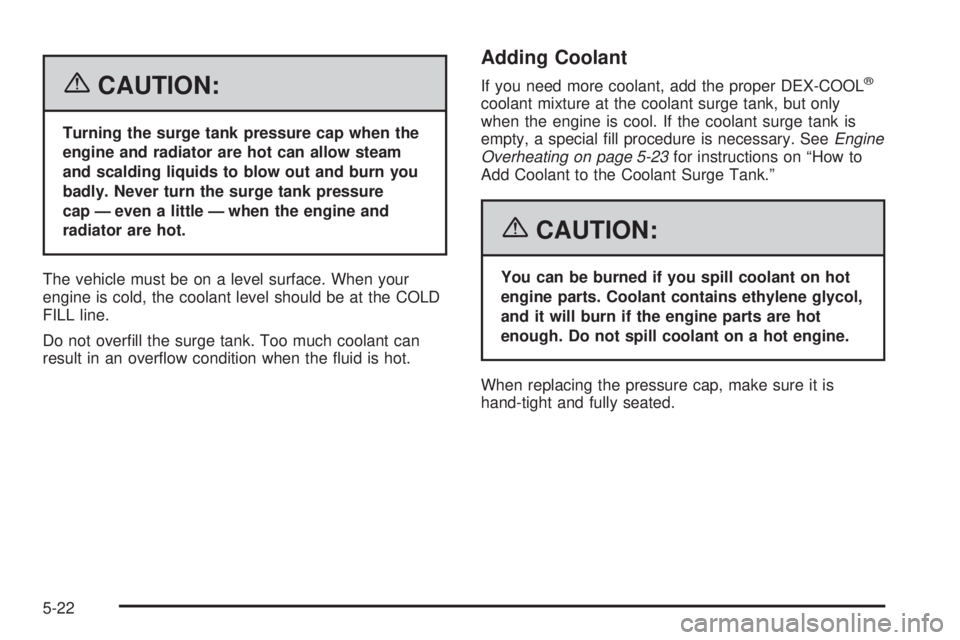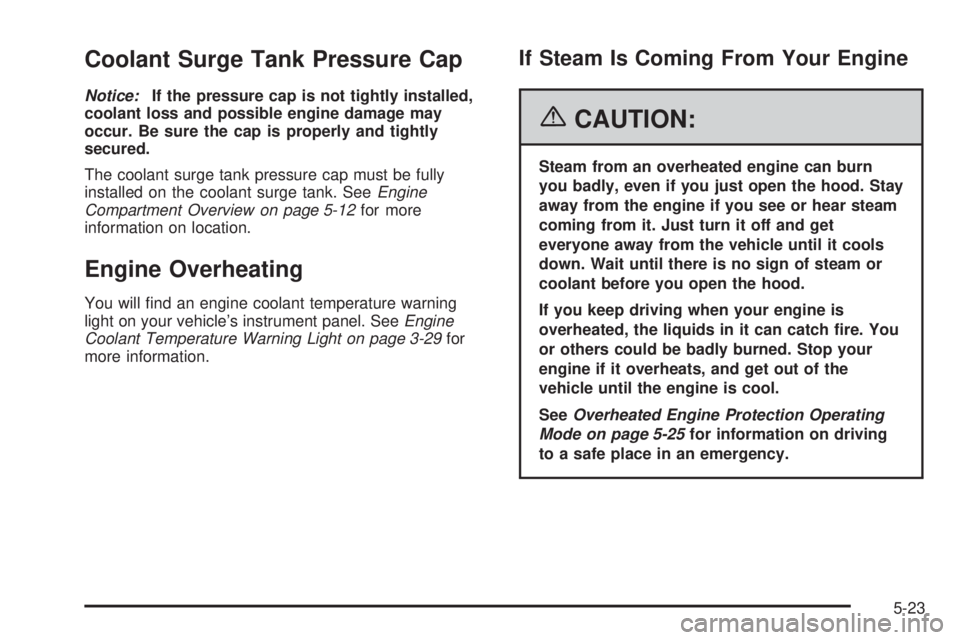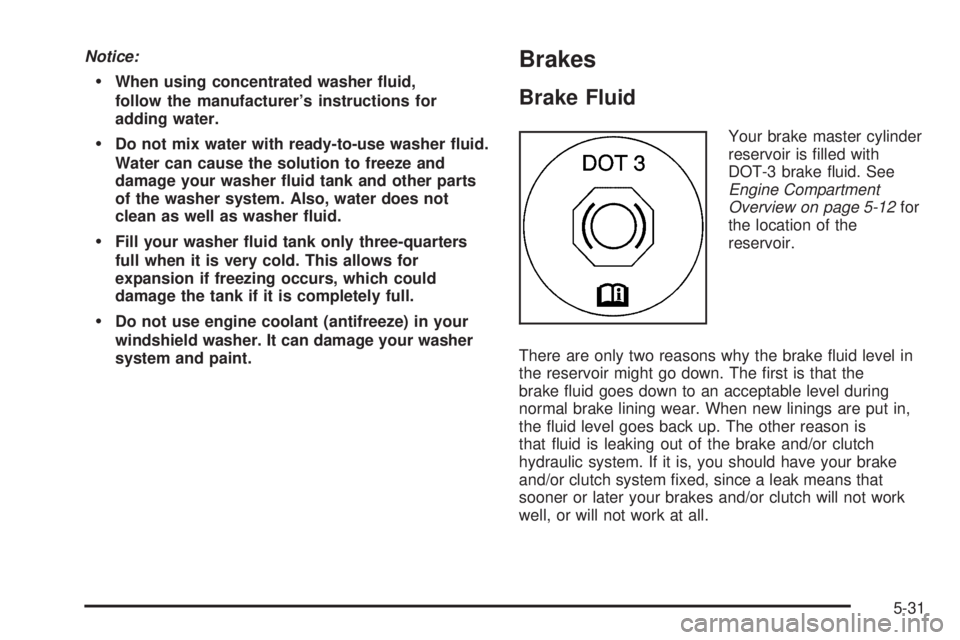engine coolant PONTIAC SOLSTICE 2006 User Guide
[x] Cancel search | Manufacturer: PONTIAC, Model Year: 2006, Model line: SOLSTICE, Model: PONTIAC SOLSTICE 2006Pages: 328, PDF Size: 1.92 MB
Page 214 of 328

{CAUTION:
Turning the surge tank pressure cap when the
engine and radiator are hot can allow steam
and scalding liquids to blow out and burn you
badly. Never turn the surge tank pressure
cap — even a little — when the engine and
radiator are hot.
The vehicle must be on a level surface. When your
engine is cold, the coolant level should be at the COLD
FILL line.
Do not over�ll the surge tank. Too much coolant can
result in an over�ow condition when the �uid is hot.
Adding Coolant
If you need more coolant, add the proper DEX-COOL®
coolant mixture at the coolant surge tank, but only
when the engine is cool. If the coolant surge tank is
empty, a special �ll procedure is necessary. SeeEngine
Overheating on page 5-23for instructions on “How to
Add Coolant to the Coolant Surge Tank.”
{CAUTION:
You can be burned if you spill coolant on hot
engine parts. Coolant contains ethylene glycol,
and it will burn if the engine parts are hot
enough. Do not spill coolant on a hot engine.
When replacing the pressure cap, make sure it is
hand-tight and fully seated.
5-22
Page 215 of 328

Coolant Surge Tank Pressure Cap
Notice:If the pressure cap is not tightly installed,
coolant loss and possible engine damage may
occur. Be sure the cap is properly and tightly
secured.
The coolant surge tank pressure cap must be fully
installed on the coolant surge tank. SeeEngine
Compartment Overview on page 5-12for more
information on location.
Engine Overheating
You will �nd an engine coolant temperature warning
light on your vehicle’s instrument panel. SeeEngine
Coolant Temperature Warning Light on page 3-29for
more information.
If Steam Is Coming From Your Engine
{CAUTION:
Steam from an overheated engine can burn
you badly, even if you just open the hood. Stay
away from the engine if you see or hear steam
coming from it. Just turn it off and get
everyone away from the vehicle until it cools
down. Wait until there is no sign of steam or
coolant before you open the hood.
If you keep driving when your engine is
overheated, the liquids in it can catch �re. You
or others could be badly burned. Stop your
engine if it overheats, and get out of the
vehicle until the engine is cool.
SeeOverheated Engine Protection Operating
Mode on page 5-25for information on driving
to a safe place in an emergency.
5-23
Page 216 of 328

Notice:If your engine catches �re because you
keep driving with no coolant, your vehicle can
be badly damaged. The costly repairs would not be
covered by your warranty. SeeOverheated Engine
Protection Operating Mode on page 5-25for
information on driving to a safe place in an
emergency.
If No Steam Is Coming From Your
Engine
An engine coolant temperature warning can indicate a
serious problem. SeeEngine Coolant Temperature
Warning Light on page 3-29.
If you get an engine coolant temperature warning, but
see or hear no steam, the problem may not be too
serious. Sometimes the engine can get a little too hot
when you:
Climb a long hill on a hot day.
Stop after high-speed driving.
Idle for long periods in traffic.If you get the engine coolant temperature warning with
no sign of steam, try this for a minute or so:
1. If you have an air conditioner and it is on, turn it off.
2. In heavy traffic, let the engine idle in NEUTRAL (N)
while stopped. If it is safe to do so, pull off the road,
shift to PARK (P) or NEUTRAL (N) and let the
engine idle.
3. Turn on your heater to full hot at the highest fan
speed and open the windows as necessary.
If you no longer have the overheat warning, you can
drive. Just to be safe, drive slower for about 10 minutes.
If the warning does not come back on, you can drive
normally.
If the warning continues and you have not stopped, pull
over, stop, and park your vehicle right away.
If there is still no sign of steam, you can idle the engine
for three minutes while you are parked. If you still
have the warning, turn off the engine and get everyone
out of the vehicle until it cools down.
You may decide not to lift the hood but to get service
help right away.
5-24
Page 217 of 328

Overheated Engine Protection
Operating Mode
This emergency operating mode allows your vehicle to
be driven to a safe place in an emergency situation. If an
overheated engine condition exists, an overheat
protection mode which alternates �ring groups of
cylinders helps prevent engine damage. In this mode, you
will notice a signi�cant loss in power and engine
performance. An engine coolant temperature warning
light will come on in the instrument panel to indicate that
an overheat condition exists. Driving extended miles (km)
in the overheat protection mode should be avoided.
Notice:After driving in the overheated engine
protection operating mode, to avoid engine damage,
allow the engine to cool before attempting any
repair. The engine oil will be severely degraded.
Repair the cause of coolant loss, change the oil and
reset the oil life system. SeeEngine Oil on
page 5-13.
Cooling System
When you decide it is safe to lift the hood, here is what
you will see:
A. Electric Engine Cooling Fans
B. Coolant Surge Tank and Pressure Cap
5-25
Page 218 of 328

{CAUTION:
An electric engine cooling fan under the hood
can start up even when the engine is not
running and can injure you. Keep hands,
clothing and tools away from any underhood
electric fan.
If the coolant inside the coolant surge tank is boiling, do
not do anything else until it cools down. The vehicle
should be parked on a level surface.
The coolant level should be at the COLD FILL line. If it
is not, you may have a leak at the pressure cap or
in the radiator hoses, heater hoses, radiator, water
pump, or somewhere in the cooling system.
{CAUTION:
Heater and radiator hoses, and other engine
parts, can be very hot. Do not touch them. If
you do, you can be burned.
Do not run the engine if there is a leak. If you
run the engine, it could lose all coolant. That
could cause an engine �re, and you could be
burned. Get any leak �xed before you drive
the vehicle.
If there seems to be no leak, with the engine on, check
to see if the electric engine cooling fans are running.
If the engine is overheating, the fans should be running.
If they are not, your vehicle needs service.
Notice:Engine damage from running your engine
without coolant is not covered by your warranty.
Notice:Using coolant other than DEX-COOL
®may
cause premature engine, heater core or radiator
corrosion. In addition, the engine coolant may
require changing sooner, at 30,000 miles (50 000 km)
or 24 months, whichever occurs �rst. Any repairs
would not be covered by your warranty. Always use
DEX-COOL
®(silicate-free) coolant in your vehicle.
5-26
Page 219 of 328

How to Add Coolant to the Coolant
Surge Tank
Notice:Your engine has a speci�c cooling system
drain and �ll procedure. Failure to follow this
procedure could cause your engine to overheat and
be severely damaged. If your engine’s cooling
system needs to be drained and re-�lled, please see
your dealer.
If you have not found a problem yet, check to see if
coolant is visible in the coolant surge tank. If coolant is
visible but the coolant level is not at the COLD FILL
line, add a 50/50 mixture of clean, drinkable water and
DEX-COOL
®coolant at the coolant surge tank, but
be sure the cooling system, including the coolant surge
tank pressure cap, is cool before you do it. See
Engine Coolant on page 5-19for more information.If no coolant is visible in the coolant surge tank, add
coolant as follows:
{CAUTION:
Steam and scalding liquids from a hot cooling
system can blow out and burn you badly. They
are under pressure, and if you turn the coolant
surge tank pressure cap — even a little — they
can come out at high speed. Never turn the
cap when the cooling system, including the
coolant surge tank pressure cap, is hot. Wait
for the cooling system and coolant surge tank
pressure cap to cool if you ever have to turn
the pressure cap.
5-27
Page 220 of 328

{CAUTION:
Adding only plain water to your cooling
system can be dangerous. Plain water, or
some other liquid such as alcohol, can boil
before the proper coolant mixture will. Your
vehicle’s coolant warning system is set for the
proper coolant mixture. With plain water or the
wrong mixture, your engine could get too hot
but you would not get the overheat warning.
Your engine could catch �re and you or others
could be burned. Use a 50/50 mixture of clean,
drinkable water and DEX-COOL
®coolant.
Notice:In cold weather, water can freeze and crack
the engine, radiator, heater core and other parts.
Use the recommended coolant and the proper
coolant mixture.
{CAUTION:
You can be burned if you spill coolant on hot
engine parts. Coolant contains ethylene glycol
and it will burn if the engine parts are hot
enough. Do not spill coolant on a hot engine.
1. You can remove the coolant surge tank pressure
cap when the cooling system, including the coolant
surge tank pressure cap and upper radiator
hose, is no longer hot. Turn the pressure cap slowly
counterclockwise about two or two and one-half
turns. If you hear a hiss, wait for that to stop. This
will allow any pressure still left to be vented out
the discharge hose.
2. Then keep turning the
pressure cap slowly,
and remove it.
5-28
Page 221 of 328

3. Fill the coolant surge tank with the proper mixture,
to the COLD FILL line. Wait about �ve minutes,
then check to see if the level is below the COLD
FILL line. If the level is below the line, add additional
coolant to bring the level up to the line. Repeat
this procedure until the level remains constant at the
COLD FILL line for at least �ve minutes.4. With the coolant surge tank pressure cap off, start
the engine and let it run until you can feel the upper
radiator hose getting hot. Watch out for the
engine cooling fans.
By this time, the coolant level inside the coolant
surge tank may be lower. If the level is lower than
the COLD FILL line, add more of the proper mixture
to the coolant surge tank until the level reaches
the COLD FILL line.
5. Then replace the pressure cap. Be sure the
pressure cap is hand-tight and fully seated.
See your dealer, if necessary.
Power Steering Fluid
SeeEngine Compartment
Overview on page 5-12for
reservoir location.
5-29
Page 223 of 328

Notice:
When using concentrated washer �uid,
follow the manufacturer’s instructions for
adding water.
Do not mix water with ready-to-use washer �uid.
Water can cause the solution to freeze and
damage your washer �uid tank and other parts
of the washer system. Also, water does not
clean as well as washer �uid.
Fill your washer �uid tank only three-quarters
full when it is very cold. This allows for
expansion if freezing occurs, which could
damage the tank if it is completely full.
Do not use engine coolant (antifreeze) in your
windshield washer. It can damage your washer
system and paint.
Brakes
Brake Fluid
Your brake master cylinder
reservoir is �lled with
DOT-3 brake �uid. See
Engine Compartment
Overview on page 5-12for
the location of the
reservoir.
There are only two reasons why the brake �uid level in
the reservoir might go down. The �rst is that the
brake �uid goes down to an acceptable level during
normal brake lining wear. When new linings are put in,
the �uid level goes back up. The other reason is
that �uid is leaking out of the brake and/or clutch
hydraulic system. If it is, you should have your brake
and/or clutch system �xed, since a leak means that
sooner or later your brakes and/or clutch will not work
well, or will not work at all.
5-31
Page 286 of 328

100,000 Miles (160 000 km)
❑Vehicles with Driver Information Center (DIC): The
Engine Oil Life System will tell you when to change
the engine oil and �lter. SeeEngine Oil Life
System on page 5-16.An Emission Control Service.
(See footnote *)
❑Vehicles without Driver Information Center: Change
engine oil and �lter (or every 3 months, whichever
occurs �rst).An Emission Control Service.
❑Rotate tires. SeeTire Inspection and Rotation on
page 5-51for proper rotation pattern and additional
information.(See footnote +.)
❑Replace spark plugs.An Emission Control Service.
❑Change automatic transmission �uid and �lter if
the vehicle is mainly driven under one or more
of these conditions:
� In heavy city traffic where the outside
temperature regularly reaches 90°F (32°C)
or higher.
� In hilly or mountainous terrain.
� Uses such as found in taxi, police, or delivery
service.
If you have not used your vehicle under severe service
conditions listed previously and, therefore, have not
changed your automatic transmission �uid, change both
the �uid and �lter.
150,000 Miles (240 000 km)
❑Drain, �ush, and re�ll cooling system (or every
60 months since last service, whichever occurs �rst).
This service can be complex; you should have
your dealer perform this service. SeeEngine Coolant
on page 5-19for what to use. Inspect hoses.
Clean radiator, condenser, pressure cap, and neck.
Pressure test the cooling system and pressure
cap.An Emission Control Service.
❑Inspect engine accessory drive belt. Visually inspect
belt for fraying, excessive cracks, or obvious damage.
Replace belt if necessary.An Emission Control
Service.
6-12